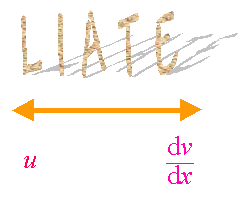
|
|

|
|
|
|
ò �(x)
dx
|
- the indefinite integral of � with respect to x, |
|
C
|
- the constant of integration, |
|
�
|
- the integrand, |
|
ò
|
- the integral sign, |
|
F
|
- an anti-derivative of �. |
|
|
- the definite integral of � with respect to x on [a, b], | |||
|
a
|
- the lower limit, | |||
|
b
|
- the upper limit. |
| 1. |
|
= �(x) | |||
| 2. |
|
= �(x) + C | |||
| 3. |
ò
dx = ò 1
dx
|
= x + C | |||
| 4. |
ò
k�(x) dx
|
= kò �(x) dx where k is a constant | |||
| 5. | ò [�(x) ± g(x)]dx | = ò �(x) dx ± ò g(x) dx |
| 1. |
|
= 0 | ||||||||||
| 2. |
|
|
||||||||||
| 3. |
|
|
| 1. | For n ¹ 1, | ||||||||||
|
(a)
|
ò
xn dx
|
|
|||||||||
|
(b)
|
ò
(ax + b)n dx
|
|
|||||||||
|
(c)
|
ò
�'(x)[�(x)]n dx
|
|
|||||||||
| 2. (a) |
|
= ln |x| + C | ||||||
|
(b)
|
|
|
||||||
|
(c)
|
|
= ln |�(x)| + C | ||||||
|
3. (a) (i)
|
ò
cos x dx
|
= sin x + C | |||
|
(ii)
|
ò
sin x dx
|
= - cos x + C | |||
|
(iii)
|
ò
sec2 x dx
|
= tan x + C | |||
|
(iv)
|
ò
cosec2 x dx
|
= - cot x + C | |||
|
(v)
|
ò
sec x tan x dx
|
= sec x + C | |||
|
(vi)
|
ò
cosec x cot x dx
|
= - cot x + C | |||
|
|
ò
cos (ax + b) dx
|
|
|||
|
|
|||||
|
|
ò
�'(x) cos �(x) dx
|
= sin �(x) + C | |||
|
|
|||||
| 4. (a) |
ò
ex dx
|
= ex + C | |||
|
(b)
|
ò
eax + b dx
|
|
|||
|
(c)
|
ò
�'(x) e�(x) dx
|
= e�(x) + C | |||
| 5. (a) (i) |
|
= sin -1 x + C | |||||||||||
(ii) |
|
|
|||||||||||
(iii) |
|
|
|||||||||||
(b) (i) |
|
= tan-1 x + C | |||||||||||
(ii) |
|
|
|||||||||||
(iii) |
|
|
|||||||||||
(c) (i) |
|
|
for |x| < a | ||||||||||
(ii) |
|
|
for |x| > a | ||||||||||
1. ò sin mx cos nx dx , ò sin mx sin nx dx or ò cos mx cos nx dx
|
sin P cos Q
|
= | ½[sin (P + Q) + sin (P - Q)] |
|
cos P cos Q
|
= | ½[cos (P + Q) + cos (P - Q)] |
|
sin P sin Q
|
= | -½[cos (P + Q) - cos (P - Q)] |
2. ò sinn x dx or ò cosn x dx
|
cos2 x
|
= ½(1 + cos 2x) |
|
sin2 x
|
= ½(1 - cos 2x) |
(b) When n is odd
| Eg. | sin3 x | = sin2 x sin x |
| = (1 - cos2 x) sin x | ||
| cos5 x | = cos4 x cos x | |
| = (1 - sin2 x)2 cos x | ||
| = (1 - 2 sin2 x + sin4 x) cos x |
|
|
|
|||
|
|
u = ax + b | |||
|
|
x = a sin q | |||
|
|
x = a tan q | |||
|
|
s = sin x | |||
|
|
c = cos x | |||
|
t = tan (x/2) |
|
 |
|